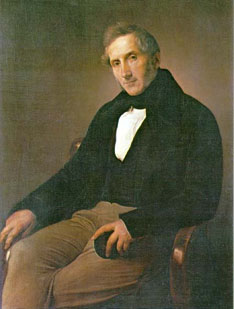| Alessandro Manzoni  AKA Alessandro Francesco Tommaso Antonio Manzoni AKA Alessandro Francesco Tommaso Antonio Manzoni
Born: 7-Mar-1785
Birthplace: Milan, Italy
Died: 22-May-1873
Location of death: Milan, Italy
Cause of death: unspecified
Remains: Buried, Cimitero Monumentale, Milan, Italy
Gender: Male
Religion: Roman Catholic
Race or Ethnicity: White
Sexual orientation: Straight
Occupation: Poet, Novelist Nationality: Italy
Executive summary: I Promessi Sposi Italian poet and novelist, was born at Milan on the 7th of March 1785. Don Pietro, his father, then about fifty, represented an old family settled near Lecco, but originally feudal lords of Barzio, in the Valsassina, where the memory of their violence is still perpetuated in a local proverb, comparing it to that of the mountain torrent. The poet's maternal grandfather, Cesare Beccaria, was a well-known author, and his mother Giulia a woman of some literary ability. Manzoni's intellect was slow in maturing, and at the various colleges where his school days were passed he ranked among the dunces. At fifteen, however, he developed a passion for poetry, and wrote two sonnets of considerable merit. On the death of his father in 1805, he joined his mother at Auteuil, and spent two years there, mixing in the literary set of the so-called "ideologues", philosophers of the 18th century school, among whom he made many friends, notably Claude Fauriel. There too he imbibed the negative creed of Voltairianism, and only after his marriage, and under the influence of his wife, did he exchange it for that fervent Catholicism which colored his later life. In 1806-07, while at Auteuil, he first appeared before the public as a poet, with two pieces, one entitled Urania, in the classical style, of which he became later the most conspicuous adversary, the other an elegy in blank verse, on the death of Count Carlo Imbonati, from whom through his mother he inherited considerable property, including the villa of Brusuglio, from that point forward his principal residence.
Manzoni's marriage in 1808 to Henriette Blondel, daughter of a Genevese banker, proved a most happy one, and he led for many years a retired domestic life, divided between literature and the picturesque husbandry of Lombardy. His intellectual energy at this period was devoted to the composition of the Inni sacri, a series of sacred lyrics, and a treatise on Catholic morality, forming a task undertaken under religious guidance in reparation for his early lapse from faith. In 1818 he had to sell his paternal inheritance, as his affairs had gone to ruin in the hands of a dishonest agent. His characteristic generosity was shown on this occasion in his dealings with his peasants, who were heavily indebted to him. He not only cancelled on the spot the record of all sums owing to him, but bade them keep for themselves the whole of the coming maize harvest.
In 1819 Manzoni published his first tragedy, Il Conte di Carmagnola, which, boldly violating all classical conventionalisms, excited a lively controversy. It was severely criticized in the Quarterly Review, in an article to which Goethe replied in its defence, "one genius," as Count de Gubernatis remarks, "having divined the other." The death of Napoleon Bonaparte in 1821 inspired Manzoni's powerful stanzas Il Cinque Maggio, the most popular lyric in the Italian language. The political events of that year, and the imprisonment of many of his friends, weighed much on Manzoni's mind, and the historical studies in which he sought distraction during his subsequent retirement at Brusuglio suggested his great work. Round the episode of the Innominato, historically identified with Bernardino Visconti, the novel I Promessi Sposi began to grow into shape, and was completed in September 1822. The work when published, after revision by friends in 1825-27, at the rate of a volume a year, at once raised its author to the first rank of literary fame. In 1822, Manzoni published his second tragedy Adelchi, turning on the overthrow by Charlemagne of the Lombard domination in Italy, and containing many veiled allusions to the existing Austrian rule. With these works Manzoni's literary career was practically closed. But he laboriously revised I Promessi Sposi in the Tuscan idiom, and in 1840 republished it in that form, with a sort of sequel, La Storia della Colonna Infame, of very inferior interest. He also wrote a small treatise on the Italian language.
The end of the poet's long life was saddened by domestic sorrows. The loss of his wife in 1833 was followed by that of several of his children, and of his mother. In 1837 he married his second wife, Teresa Borri, widow of Count Stampa, whom he also survived, while of nine children born to him in his two marriages all but two preceded him to the grave. The death of his eldest son, Pier Luigi, on the 28th of April 1873, was the final blow which hastened his end; he fell ill immediately, and died of cerebral meningitis on the 22nd of May. His country mourned him with almost royal pomp, and his remains, after lying in state for some days, were followed to the cemetery of Milan by a vast cortege, including the royal princes and all the great officers of state. But his noblest monument was Verdi's Requiem, specially written to honour his memory.
Biographical sketches of Manzoni have been published by Cesare Cantu (1885), Angelo de Gubernatis (1879), Arturo Graf (1898). Some of his letters have been published by Giovanni Sforza (1882). Father: Pietro Manzoni
Mother: Giulia Beccaria
Wife: Henriette-Louise Blondel (m. 1808)
Do you know something we don't?
Submit a correction or make a comment about this profile
Copyright ©2019 Soylent Communications
|